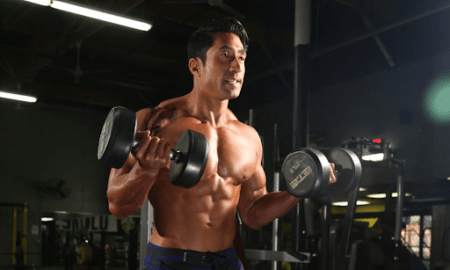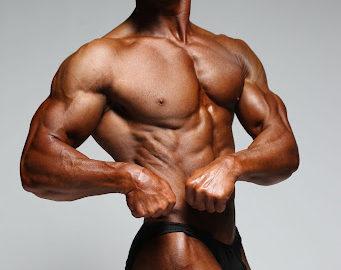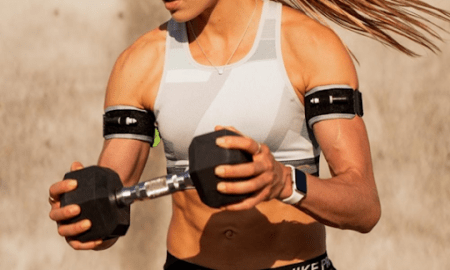Q: Here’s my workout schedule for your review. Sunday: legs; Monday: chest; Tuesday: back; Wednesday: off or shoulders, traps; Thursday: shoulders, traps; Friday: triceps, biceps, forearms. I train abs almost every day. How can I get my triceps bigger without overtraining? I’m thinking about dropping arm day and doing triceps only after chest and biceps after back. I just started locking out hard. Any suggestions? Also, what do you like for developing the medial deltoid? I just started back up in February. I’ve gone from 140 pounds to 195 at 15 percent bodyfat. My bench has moved from 105 to 315 pounds—no drugs. I lifted for nine months in 2006 and was at 215, but 20 of those pounds were from steroids. It was just water weight, and I was 18 years old—young and dumb. If I quit for 3 1/2 years and started over at 140 pounds training naturally, can I still compete in drug-free shows? I could pass a lie detector test. I admire what you’ve done and your rugged, classic, Reg Park–like physique.
A: It sounds as if you’re thinking of doing less work to make your triceps grow. I think you should take the opposite approach and do more instead of less. I suggest you do one heavy arm—triceps focus—workout a week followed by a lighter arm workout later in the week.
I also recommend that you train triceps with chest at your Monday session and train biceps with back on your Tuesday session. I like the way you take a rest day on Wednesday, followed by shoulders on Thursday and arms on Friday.
When you do your arm workout on Friday, make it more of a light, pumping-type workout instead of a heavy, low-rep session. Doing a heavy workout followed by a lighter one later in the week is a great way to get a stubborn bodypart to grow again.
I did the same thing with my leg workouts several years ago. I did my normal heavy leg workout on Tuesday. That consisted of heavy leg presses, heavy squats, heavy hack squats and heavy front squats for six to 10 reps. My legs would typically be sore for two to three days after that workout.
On Saturday I trained legs again, but with a completely different workout. I avoided the heavy squats and hack squats to give my knees and lower back a break. Instead, I did more of a pumping workout for the quads.
That second workout didn’t cause as much muscle-tissue damage as the Tuesday leg workout did. It pumped up the muscles, though, and helped them grow by getting blood into the tissues. I found that approach to be much more effective than waiting a full seven days to train legs again.
I used exercises like leg extensions, leg presses, sissy squats and lunges. I never went heavy on any of those. I used lighter weights and did higher reps—12 to 20—and I supersetted two exercises instead of doing straight sets. I got an awesome pump and blew up my quads, but I never got sore, so I could do my heavy leg workout three days later.
You could do the same thing with your triceps. On Tuesday, after you finish training chest, work your triceps with a basic, heavy workout. Use exercises such as close-grip bench presses, parallel-bar dips, lying triceps extensions and pushdowns. Do them for six to 10 reps, focusing on proper form and increasing the resistance from week to week.
When you train arms later in the week, switch gears and do a much lighter workout. I suggest that you superset a biceps exercise with a triceps exercise. Since your triceps need more attention than your biceps, do the triceps exercise first on each superset.
Just as I did with my legs, I recommend that you use higher reps for the second arm workout. Do 15 reps on the first set, 12 on the second set and 10 on the third set. Do three sets for each exercise, and do two to three exercises for both the triceps and biceps, for a total of six to nine sets in the workout. Remember, this program is designed to really pump up the arm muscles to promote growth, so go for the ultimate pump. Have a look at the sample superset routine for arms that appears on this page.
Any type of lateral raise using either dumbbells or cables is the best exercise for building the medial, or side, deltoids. Performing laterals with the correct form is the key.
I like to do them with my arms straight and bring the dumbbells out as far as possible. I often see bodybuilders doing lateral raises with their elbows bent or twisting their arms at different angles; that technique doesn’t really hit the side delts. It’s important to keep your arms straight and tight and bring the dumbbells out to the sides as strictly as possible.
One technique that really works for building up the side deltoids is drop sets. When I do lateral raises with dumbbells, I work up to a heavy weight on my third set and then immediately drop to a lighter weight and continue the set. I do one or two sets using that technique—very effective.
As for your question regarding your eligibility for competing in a natural bodybuilding event, that depends on the rules of the specific organization. Some natural bodybuilding organizations, such as the WNBF and the INBA, require their competitors to be drug-free for seven years. The NPC Team Universe, on the other hand, requires its competitors to be drug-free for only one year.
Q: I’ve gotten to know you through your posts on Bodybuilding.com, and I’ve come to really respect you and what you’ve done with your physique. I feel the same as you on many aspects of bodybuilding. I will never compete because of the drugs; however, I do the training to feel good. The problem I have now is that I don’t know if what I’m doing is good or bad. I have some results, but nothing astounding like you. I’m 175 pounds at 5’ 9”. I’m very determined, and I would like to see just how far I can push myself if I go in the right direction. I just don’t know what the right direction is. I’ve been working out for four years, and I really like bodybuilding. I read IRON MAN, and I do what I can to build my physique like yours. I understand that it takes time. I’m a patient man, and I’m willing to put the time and effort into it the way you did. Can you help me figure out where to take it from here? What separates a normal guy like me, who has the dedication, from a guy like you, who has the same dedication? Time? A personal trainer? I train at work, and I take only whey isolate and creatine. If you could give me a couple of pointers, that would be great.
A: Sounds like you need some goals in order to motivate yourself and move forward with your bodybuilding training. That’s obviously very important, as anyone who has engaged in a fitness program can tell you. If you don’t stay motivated, it won’t take long before the workouts become more infrequent and the diet starts to stray from healthful bodybuilding food to junk food.
What always motivated me was competition. When I started bodybuilding at 14 years old, my goal was not just to build up my physique. I wanted to build up my physique and then start competing. I had my eyes set on one day winning the coveted Mr. Universe contest. I still remember seeing pictures of Kal Szkalak winning the ’77 IFBB Mr. Universe contest in the magazines. He was standing on the winner’s podium holding his trophy up, and he looked magnificent. When I saw those pictures, I told myself that I wanted to do the same thing one day.
So, as I began my training program, my mind was focused on winning the Mr. Universe contest. I knew it would take me years of training before I could make that goal a reality, but that was the initial motivation. I was so psyched up in the beginning that I would get up at 5 a.m. every day to train before I went to school, and then I would work out again as soon as I got home. I was training six days a week, twice a day because I was in such a hurry to build my body.
Once I started competing, that really increased my motivation because I was able to clearly see what my weak points were and what I needed to improve. I wanted to win so bad that my motivation went through the roof!
You were asking what separated me from others who did not achieve the same success in building their physique. It obviously takes time and hard work, but it all begins with your motivation and desire.
I was only 135 pounds when I started training at 14. In the beginning, I had a hard time imagining that I could look like the bodybuilders I admired so much in the magazines. They seemed to be from another planet!
It helped when I took some pictures of myself after a year of training. Although I only weighed 155 pounds at the time, I could see that I had the structure and the muscle shape to one day build a winning physique. It was going to take lots of effort and time, but I could see the potential was there.
That realization helped motivate me to continue training hard and eating the foods I needed to eat. Whenever you have a long-term goal, it’s important to “keep the eyes on the prize” in order to stay motivated.
What I would suggest for you is that you have to decide what you want to accomplish with your bodybuilding. If you want to compete, you should be clear about what your goal is. Do you want to win a big title, or do you just want to compete for personal satisfaction?
If you don’t want to compete, what are you looking to do with your physique? Do you want more size, do you want a better-shaped physique, do you want less bodyfat? You need to be clear about exactly what you want to achieve before you can achieve it.
Believe it or not, that’s a common problem for many people engaged in a fitness program. I see people wandering around the gym all the time with no motivation and no energy. They watch the TVs at the gym, they float from machine to machine, and there is no sense of urgency or excitement.
Compare those people to the ones who have goals. People who are training for a purpose train much harder and with more energy. They know exactly why they are at the gym and what they have to accomplish in their workouts in order to achieve their goals. As Arnold once said, “You never notice the winners in the gym because they are too busy working hard in the gym and staying focused on their workout.”
Editor’s note: John Hansen has won the Mr. Natural Olympia and is a two-time Natural Mr. Universe winner. Check out his Web site at www.NaturalOlympia.com, or send questions or comments to him at [email protected]. Look for John’s DVD, “Natural Bodybuilding Seminar and Competitions,” along with his book, Natural Bodybuilding, and his training DVD, “Real Muscle,” at his Web site or at Home Gym Warehouse, www.Home-Gym.com. Listen to John’s new radio show, “Natural Bodybuilding Radio,” at www.NaturalBodybuildingRadio.com. You can send written correspondence to John Hansen, P.O. Box 3003, Darien, IL 60561. IM




















You must be logged in to post a comment Login